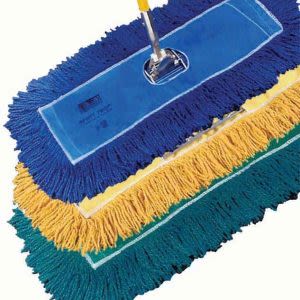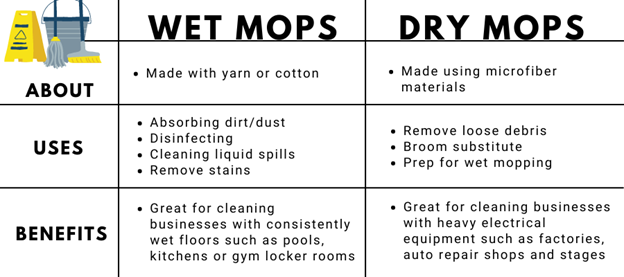
When it comes to dry mops vs. wet mops each has its own purpose and benefit. Used correctly, these mops will leave floors thoroughly and effectively cleaned. As long as the right steps are followed, floors can be free of dust and debris and left streak-free, spill-free and disinfected.
To effectively clean floors, it is essential to understand how and why each mop is used. This, together with step by step instructions and the proper order for mopping, will not only achieve clean floors but will add to the maintenance, value and safety of a property. From the front rooms to the back rooms to the washrooms—the appearance of your business matters.

Differences Between a Dry Mop and Wet Mop
The name of each mop, “dry” and “wet”, describe their characteristics and purposes well. A dry mop is used dry to pick up dirt, debris and dust. It is used without water. It is also used before a wet mop when a thorough floor cleaning, start to finish is desired. The wet mop is used with water and a cleaning solution. This mop will remove built-up debris and spills from the floor while disinfecting. Understanding the differences between the two mops will help achieve sparkling clean floors each time a floor is mopped.

The Purpose of a Dry Mop and Wet Mop
Isn’t a mop, a mop? Not when it comes to a wet mop and dry mop. Each mop has its own purpose. When used in the correct setting, and in the correct way, each mop will leave floors free and clear of debris.
Think of a dry mop as a broom, only better. It is a broom and a cleaner in one. A dry mop is designed with microfiber that collects debris as it is pushed across the floor. Using a broom simply moves debris around. Using a dry mop is a great way to care for floors throughout the work day. A quick, dry mopping of the floors will remove dirt and loose debris. This can be done while working around customers without creating obstacles or a wet, slippery floor.
When it comes to the wet mop, when used incorrectly, it can actually leave the floor dirtier than before it was mopped. The purpose of the wet mop is to clean up any gunk or dried debris that is left on the floors surface after it was been swept or dry mopped. It is also used for cleaning up spills when they happen. Aside from cleaning up the occasional spill, wet mopping is generally reserved for the end of the day when wet floors will not present a risk of injurt or create obstacles to employees or patrons.
How To Use a Wet Mop and Dry Mop
Following the proper steps on how to use either a wet or dry mop will leave floors cared for, clean and maintained. There have been instances when wet mops have been pushed aside and the mop deemed faulty because the floors were left dirtier than beofre the wet mop touched it. This isn’t due to any failure of the wet mop. This happens when the mop is not used correctly and with an understanding of how the wet mop works. Read on to learn how to properly use a wet and dry mop.
How To Use a Wet Mop
Once all the loose dust, dirt or debris has been removed from the floor with a broom or dry mop, a wet mop can be used. The goal of the wet mop is to absorb any left over dirt. Start with the wet mop, hot water and cleaning solution. Once the mop is wet from the water/solution, it is best to work in sections so that as one section soaks, another section can be cleaned
Follow these steps on to use a wet mop:
Soak a section of the floor and let stand for a couple of minutes. The heat, water, and cleaning solution will loosen the dirt and debris.
Rinse the wet mop and wring it out to remove as much water as possible.
Wipe the floor with the mop using a back-and-forth motion. This soaks up the water and dirt at the same time.
Once the mop feels heavy and full, rinse the mop, wring it out, and repeat until finished.
Wet mops, by design, are extremely absorbent. This absorbency is the key to their effectiveness. Soaking the floor loosens the dirt, then a rinsed and wrung-out mop absorbs the water and dirt as it passes over. Rinsing the floor leaves the floor streak-free.
How To Use a Dry Mop
Dry mop procedures are a lot less involved than that of the wet mop. Using a dry mop first will make wet mopping easier and ensure a cleaner floor.
Follow these steps on how to use a dry mop:
Keep the mop head against the floor and push. Be sure not to lift the dry mop in the middle of a stroke.
Lift the mop head every few strokes and shake over a trash can to remove the collected debris.
Go back and forth over the floor in a uniform pattern, overlapping a few inches on each stroke.
If you are using a spray on the floor, follow the manufacturer’s instructions for the most effective use. A disinfectant can also be lightly sprayed on a dry mop before use.
The floor care process isn’t complete unless it includes the use of both a wet mop and a dry mop. Taking advantage of the cleaning benefits each mop brings will make the floorcare process easier, more efficient and thorough.
Alsco Floor Services
Alsco knows that a clean, safe environment can make-or-break whether your customers return. The appearance of your business matters. Alsco can help manage and improve floor care and also offers comprehensive facility services. We provide products and services to help your business, and floors, shine.
Sources
https://www.osha.gov/cleaning-industry. United State Department of Labor: The Occupational Saftey and Health Administration.
https://businesspartnermagazine.com/how-often-should-business-professionally-cleaned/. Business Partner Magazine. (March 2021).
https://exclusive.multibriefs.com/content/why-taking-workplace-hygiene-seriously-benefits-your-business/business-management-services-risk-management. MultiBriefs. (July 2021)
https://workingcapitalreview.com/2016/04/appearance-matters-include-a-business-strategy-that-keeps-your-facility-looking-good/. Working Capital Review. (April 2016).
